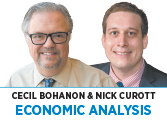Subscriber Benefit
As a subscriber you can listen to articles at work, in the car, or while you work out. Subscribe Now Ever hear the story of the King’s Coin Flipper? The foolish King of Fredonia was looking for the luckiest person in his kingdom to be his adviser. So he declared a feast on his palace grounds. One-hundred-thousand subjects showed up. Each one was given a penny. After they were fed, the members of the Royal Guard ordered them to participate in a coin-flipping contest. At the king’s command, all flipped their coins. The king then called out “heads.” All whose coin had turned up “tails” were ordered to leave. That left 50,000 subjects on the grounds.
Ever hear the story of the King’s Coin Flipper? The foolish King of Fredonia was looking for the luckiest person in his kingdom to be his adviser. So he declared a feast on his palace grounds. One-hundred-thousand subjects showed up. Each one was given a penny. After they were fed, the members of the Royal Guard ordered them to participate in a coin-flipping contest. At the king’s command, all flipped their coins. The king then called out “heads.” All whose coin had turned up “tails” were ordered to leave. That left 50,000 subjects on the grounds.
A bit later, a second round of coin-flipping began, and the king called out “tails.” All those whose coin had turned up “heads” were ordered to go—leaving 25,000 subjects on the grounds. After 16 rounds, one lady, a Miss Hilda Bruggeheddle—whose coin flip had matched what the king called out in each round—was declared his adviser because she was the luckiest person in the kingdom.
What does this silly story have to do with the economy? Actually, quite a bit. Since at least the time of John Maynard Keynes, if not earlier, economic pundits have been looking for a “golden” economic signal that predicts economic downturns. Since there are thousands of potential economic signals out there, it isn’t surprising that we can find a “lucky winner” (just like Miss Hilda) that precedes all recessions.
It is true that it is unusual for long-term interest rates to be lower than short-term interest rates. It is also true that all eight of the last recessions have been preceded by such an “inversion” one to two years before the recession began, and there has been only one “false signal.” Yet the relationship does not appear to hold outside of our country, which is curious.
As the Economist magazine pointed out: “In a dataset of 16 other rich countries, reaching as far back as 1960, 51 of the 95 recessions were not preceded by an inversion during the previous two years. Moreover, the curve seems prone to crying wolf. On 63 occasions, these non-American economies kept growing despite inverted yield curves.” The same article pointed out, however, that such inversions did seem to predict slowdowns in economic growth.
Economies are complicated. It’s not wise to read too much into a single indicator.•
__________
Bohanon and Curott are professors of economics at Ball State University. Send comments to ibjedit@ibj.com.
Please enable JavaScript to view this content.
